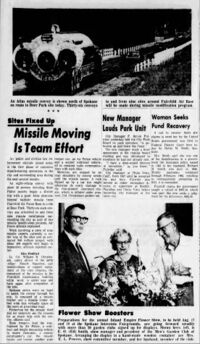1963-08-09-sc-p5-atlas-upgrade: Difference between revisions
(initial upload) |
m (Bot: Adding category Atlas Missiles) |
||
| Line 29: | Line 29: | ||
Motorists are stopped by on road shoulders by convoy scouts until the missile passes. A rock flipped up by a car tire might otherwise do costly damage to the thin-skinned aluminum missile, which is inflated under pressure, Col. Christensen pointed out. | Motorists are stopped by on road shoulders by convoy scouts until the missile passes. A rock flipped up by a car tire might otherwise do costly damage to the thin-skinned aluminum missile, which is inflated under pressure, Col. Christensen pointed out. | ||
</blockquote> | </blockquote> | ||
[[Category: Newspaper Clipping]] | |||
[[Category:Newspaper Clipping]] | |||
[[Category:Atlas Missiles]] | |||
Latest revision as of 08:07, 16 August 2023
August 09, 1963 Spokane Daily Chronicle Page 5:
[photo]
An Atlas missile convoy is shown north of Spokane en route to Deer Park site today. Thirty-six convoys to and from nine sites around Fairchild Air Base will be made during missile modification program.
Sites Fixed Up
Missile Moving Is Team Effort
Air police and civilian law enforcement officials joined today in the first phase of extensive missile-moving operations in the city and surrounding area during the next several months.
An eight-vehicle convoy with about 20 persons including State Patrol escorts began a 42-mile trip with a giant Atlas intercontinental ballistic missile from Fairchild Air Force Base to a site at Deer Park. Thirty-six such convoys are scheduled to and from nine missile installations surrounding the city as part of two missile modification projects, Air Force officials explained.
Work involving a crew of nine missile experts currently is under way at the sites and an estimated $40 million project with about 400 experts will begin in September, officials reported earlier.
Sites Modified
Lt. Col. William R. Christensen, safety officer of the 567th (Atlas) Missile Squadron, said modifications of support equipment at the sites requires the movement of the missiles to the Fairchild maintenance building while work is under way and back again after completion of the jobs.
Spokane police were on hand to assist the convoy through the city. It consisted of a missile tractor and a missile trailer 16-feet wide that virtually takes all the room on a two-lane road.
Protection for the missile itself and for motorists are the reasons for so much help with the convoy, officers said.
State troopers lead the way, followed by Air Police, a wide-load and height measuring vehicle to insure clearance, a convoy commander's car, the missile trailer and tractor, another state
trooper car, an Air Police vehicle and a second wide-load vehicle, all in constant radio communications with each other.
Motorists are stopped by on road shoulders by convoy scouts until the missile passes. A rock flipped up by a car tire might otherwise do costly damage to the thin-skinned aluminum missile, which is inflated under pressure, Col. Christensen pointed out.
